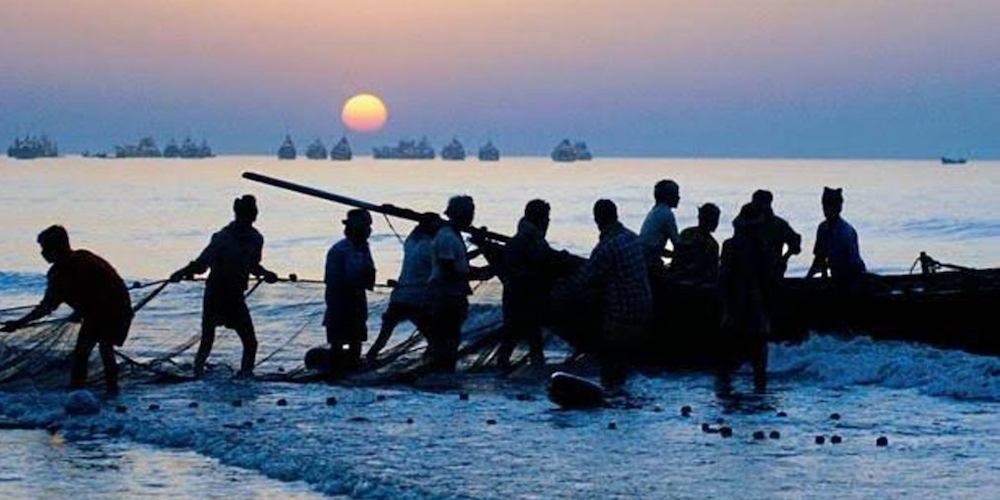Kisan Credit Card of Big Help for the Growing Fisheries Sector

In its two years Pradhan Mantri Matsya Sampada Yojana (PMMSY) seems to have accomplished a lot.
On its second anniversary, which was celebrated on September 10 at the national capital, new plans setting new targets for the fish-farmers of the country have been envisaged by the officials of the Department of Fisheries, Union Ministry of Fisheries, and Animal Husbandry and Dairying.
Shri Parshottam Rupala, Union Minister of Fisheries, Animal Husbandry was Chief Guest at the event. Dr. L. Murugan, Minister of State, FAHD and I&B, Shri Tarun Shridhar, Former Secretary, Ministry of Fisheries, Animal Husbandry and Dairying and Dr. S. Ayyappan, Former Director General, Indian Council of Agricultural Research were Guests of Honour and Shri Jatindra Nath Swain, Secretary, Ministry of FAHD was also present.
About 300 fishers and fish farmers along with senior officials from States/UTs attended the celebration and shared their experiences and success stories. The event witnessed the launch of Booklets on PMMSY & its achievements, “Matsya Sampada “ and Tilapia Action Plan as a part of Export Diversification, Scampi Action Plan, and National Seed Plan.
Union Minister Shri Rupala congratulated the Department of Fisheries and PMC team for ideating the event, publishing booklets and representing it in an interesting manner that captures the essence and amalgamation of achievements and future action plan.
Dr. L Murugan shared how the fishery sector is programmed for sectoral transformation in India from its independence to the present day and the ancient history of subsistence of the fishery sector as a crucial sector in India.
Shri Jatindra Nath Swain shared how to utilize the true potential of our reservoirs and natural resources by infusion of technology and public stocking and rejuvenation of water bodies by river and sea ranching programme. He addressed the fishery and fish farmers as the nucleus of PMMSY and congratulated them for their success in the fishery sector under the PMMSY scheme.
Shri Tarun Shridhar shared his experience regarding the introduction of the Shrimp revolution in the nation and shared valuable information pertinent to diversification in the fisheries sector. Dr. S. Ayappan stressed on the importance of technology and innovations and the usage of scientific practices in fish farming for bringing India to the top of the global map in terms of productivity. Dr. C Suvarna, Chief Executive, NFDB shared that the PMMSY scheme has a well structured implementation framework.
The Government of India, as part of the ‘Atma Nirbhar Bharat’ package, introduced the Pradhan Mantri Matsya Sampada Yojana (PMMSY) with investments to the tune of Rs. 20,050 crores, highest ever investment in the sector.
In the last two years, though Covid-19 has impacted the sector adversely, the sector has managed to bounce back under the scheme by adopting a series of systematic approaches.
Fisheries growth rate in the last 2 years shows an impressive growth of 14.3% from 2019-20 to 2021-22. Further, fish production reached an all-time high of 141.64 lakh tons during 2019-20 to 161.87 lakh tons (provisional) during 2021-22.
Similarly in exports, India has achieved the all-time high exports of 13.64 lakh tonnes of fishery products valuing Rs 57,587 crores (USD 7.76 bn), dominated by exports of shrimps. At present India is exporting to 123 countries.
For development of Inland fisheries, 20 integrated reservoir development projects have been undertaken by installing 20,622 cages. For adopting driving in technology to enhance productivity, 3117 RAS units and 2693 bio-floc units have been transposed as functional. Nearly 1600 ha area has been subsumed under saline and alkaline area development initiatives.
For development of Marine fisheries 276 deep sea fishing vessels have been approved and initiated for procurement. 10 marine hatcheries for providing quality seed to the farmers have been approved. Nearly 1556 nos. of cages going to be installed in sea have been sanctioned already.
So far PMMSY has supported 31.47 lakh farmers under insurance coverage from 22 states and 7 UTs and additional 6.77 lakh farmers have been covered for livelihood and nutritional support during lean/ban period.
Further, to help meet working capital and short-term credit requirements of the sector, the Government has extended the Kisan Credit Card (KCC) to Fishers, Fish Farmers, Self Help Groups (SHGs), Joint Liability Groups, Women Groups, etc. As on Jan 2022, a total of 6,35,783 applications have been submitted and an amount of Rs 1,04,179 Lakh has been sanctioned.
To strengthen the fisheries infrastructure and augment fish production, as of date a total of 19 fishing harbors and fish landing centers proposals have been approved to the tune of Rs. 912.03 crores. Through the PMMSY, it is envisaged that an estimated 68 lakh Employment will be generated by the end of 2024-25.
Earlier, Marine fish production dominated India’s total fish production. However, with adoption of science-based practices and technology in 2019, 74% of fish production was contributed by inland fisheries and the rest 26% by marine fisheries.
In this scheme, Aquaculture promotion will be undertaken especially in the saline and alkaline areas of Northern India. Another key concern is Aquatic health management and focus is laid on the address of diseases, anti-biotic and residue issues which will be supported by an integrated laboratory network.
It may be noted that Prime Minister Narendra Modi envisioned PMMSY as a tool of Atma Nirbhar Bharat towards the purpose of rural development by utilizing rural resources and boosting rural economy in a rapid way. PMMSY can be a key factor for augmenting the livelihood of the rural sector of the nation.
The main motto of PMMSY is ‘Reform, Perform and Transform’ in the fisheries sector.
The reforms and initiatives in PMMSY scheme have been inculcated in core & trunk infrastructure development, modernization of Indian fisheries, especially the push for new fishing harbours/landing centres, modernisation and mechanization of traditional fishermen crafts-trawlers-deep sea going vessels, provision of post-harvest facilities to reduce post-harvest loss, cold chains facilities, clean and hygienic fish markets, two wheelers with ice boxes and many more.
Fishermen are provided with insurance cover, financial assistance and a facility of Kisan Credit Card as well. PMMSY has set a way forward to enhance its utilization by invigorating the rural economy.
The interventions in the scheme have been adequately developed to cater to multi-pronged aspects in terms of people, process and technology which are the 3 important pillars of continued growth and change. These 3 pillars comprise various aspects across the chain: sustainable production practices; adequate processing infrastructure creation; target marketing for end consumer; inclusive policies and ample regulatory frameworks for adoption.



